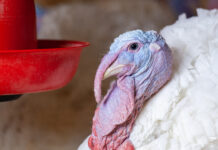
Due to its central position between breeder farms and poultry production houses for meat and eggs, optimised hatchery hygiene plays a crucial role in preventing the spread of pathogens in the poultry value chain.
Optimised hygiene in the hatchery is dependent on three key areas:
- preventing pathogens from entering the hatchery, ie. maintaining bio-security;
- avoiding cross-contamination or the transfer of pathogens within the hatchery;
- inhibiting further pathogenic development in the hatchery ie. cleaning and disinfection.
This article focuses on the prevention of cross-contamination in the hatchery from relatively ‘dirty’ rooms in the hatchery, such as the chick processing room, to what should be the cleanest room, the setter room. To prevent cross-contamination, it is important to clearly demarcate the different hygienic zones in the hatchery: egg arrival area; setter room; candling/transfer room; hatcher room; chick handling and despatch room. In a well-designed hatchery, the practical implementation of the “clean should never meet dirty” rule is easily achievable. For example, eggs being transferred to the hatcher do not cross the path of chicks just being pulled. After being washed and disinfected, hatcher baskets do not pass through the chick room or any area where processing takes place, on their way to the transfer room. And importantly, all hatchery staff including the technician responsible for the maintenance should not walk from the chick processing room to the setter room on a hatch day. Differently coloured hatchery clothing and shoes, as well as tools like floor rubbers, greatly help to enforce hygiene-responsible behaviour by hatchery personnel. Exploders – often caused by Pseudomonas spp – are an important source of cross-contamination between batches within the same setter. To reduce this risk, batches with an increased incidence of exploders should be transferred to the hatcher last.
Strictly applying the “One batch per hatcher” rule, enabled by limiting the capacity of the hatchers, greatly prevents the risk of cross contamination, for example from older to younger batches. In a well-designed hatchery the number of hatchers per hatcher room is based on the daily production of chicks. This prevents recontamination after cleaning and disinfection, so minimizing the risk of contaminating tomorrow’s hatch.
Chick down, also a potential contaminant, is easily airborne. Its movement must therefore be controlled to prevent cross-contamination. The setter room, to be maintained as the cleanest room in the hatchery, should be kept overpressure in relation to the hatcher rooms. The accumulation of down in air ducts should be avoided, because this forms breeding grounds for moulds like Aspergillus spp. Air leaving the hatcher – and ideally also the setter – should be brought directly into exhaust plenums that can easily be cleaned and disinfected. The use of air ducts should be restricted for clean, unused air only. In the hatcher, condensation on the cooling surface is normal and the moisture will catch the majority of fluff if the surface is large enough. The integration of cooling pipes inside the wall panels creates a large surface area that significantly minimizes the risk of cross contamination, while at the same time greatly reducing cleaning time and promoting excellent disinfection results.
Advice
- Organize regular hygiene-awareness training for hatchery staff; people are often the weakest link in the “hygienic chain”.
- Apply the rule “clean should never meet dirty” strictly, for eggs, people, air and items such as trolleys and trays.
- Maintain setter room in overpressure in relation to hatcher rooms to avoid the entrance of fluff.
- Transfer batches with an increased risk of exploders to the hatcher last.
- Plan daily chick production based on the number of hatchers per hatcher room.
















